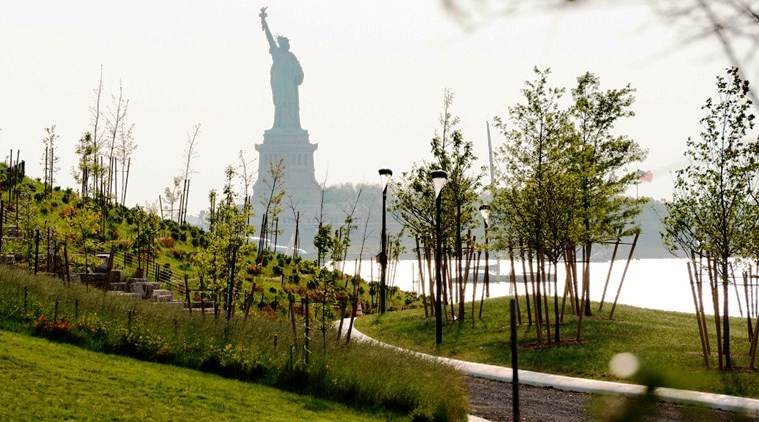Hang out with trees
Appreciate them for quietly doing a job that allows us to continue to live and breathe.

We should touch them, feel them, look up at them, and appreciate them for quietly doing a job that allows us to continue living and breathing.
There is a park bench on The Mall, the only straight road within Central Park in New York City, dedicated to Regina Alvarez. It was a stranger who made the donation, and the plaque simply reads: “Regina Alvarez who cares for the park”. I met Alvarez who has worked at the Central Park Conservancy for 19 years, through an app called Detour, which takes you on a guided tour of an area and lets you in on little details which you might otherwise entirely miss.
Alvarez works to save the American elms — graceful, stately trees, whose branches are known as “habits”. Dig a little deeper and you will find the elms were popular in the 19th century, so much so that by the 20th century many American streets were lined with only elms and the shade resembled the insides of a Cathedral ceiling. But the Dutch elm disease in the 1950s was its downfall, and soon elm after elm was knocked down — minced into little pieces by a fungal disease, or chewed up by beetles.
So on a nippy Friday morning, on the same day that the Union government here expressed its intention to fell thousands of trees to make way for a housing project in Delhi, I was learning about a “living museum” and staring up at some of the last surviving American elms. “Keeping those magnificent trees alive requires tremendous planning and labour,” the narrator Adrian Benepe, who served as Commissioner of Parks, said. “This is the perfect example of the hard work required to maintain the vision of those who created Central Park,” he continued.
Central Park embodied lofty ideas, he said, and was designed by “romantic idealists” who believed public parks improved democracy and that nature rejuvenated the body and soul. Benepe narrated how people gathered on the lawns of the park soon after the twin towers fell in 2001. He found it a bit odd initially, he admitted and then understood that it, in fact, made perfect sense. People gathered there because they felt strength in the park, solidarity and togetherness.
It wasn’t the smoothest journey for the city of New York to pencil in a 843-acre urban park that runs through Manhattan. For many years, apparently, it was rundown, dangerous, neglected and unloved. Much later, in the hour-long narration after Benepe took us from one point to another, opening our eyes wider to the strength of nature and more importantly to the dedication of humans who work to preserve it, he asked if we felt transformed.
I did. I realised how similar New York was to New Delhi. The initial plans drawn up for India’s capital allocated space for parks, and tree-lined avenues. Both cities are filled with migrants looking for homes, they are bursting at the seams and are deliberately drawing space for trees into their blueprints — through urban parks, city forests and tree-lined boulevards. Like the “oasis” that is Central Park, Delhi has its Jahanpanah forest and Lodhi Gardens, places where tree canopies shelter precious micro-climates.
Curiously, for a city built to house bureaucrats, it has a conflicted relationship with trees. Scroll through environment impact assessment reports submitted to the Ministry of Environment for a new project, and it asks for permission to cut trees to accommodate concrete structures, while also promising to line designated green belts with trees.
Yet unlike Alvarez, many of the men and women who initially factored in flora into Delhi’s Master plans, are unknown, among them my grandfather who worked in the Delhi Development Authority, who was involved in the initial planning of several South Delhi colonies. I was too young, and later too oblivious, to hear his stories in detail while he was alive. He was a civil engineer who loved trees, and often spoke of how it was a conscious effort to plan colonies in the national capital around tree-filled parks where people gathered to talk, laugh, play cricket, or shell peas.
In the last few weeks, the fight to save trees in Delhi has brought people together in a way that is refreshing in an urban centre, where the poor air has confronted us to the extent that we really have no choice but to save those trees. But it confronts us with a larger question: Do we want to leave a city, or even a country to our children, so drastically different to the one we grew up in? Is it fair to expect future generations to live in a city which prioritises pointy high-rises over green canopies?
I asked a friend who often travels from India to visit his parents in Canada what a tree meant to him. “I take them for granted in Canada,” he said. “Here they are precious. I love the ones that surround my office in Hauz Khas. I emerge from hours in a basement office, and there they are when I poke my head out.” Environmentalist Romulus Whitaker recently said he believed touching a snake opens people’s minds and changes it forever.
Maybe it is the same prescription for trees: We should touch them, feel them, look up at them, and appreciate them for quietly doing a job that allows us to continue living and breathing. Studies from across the world reveal a beautiful relationship that people have with “their” trees. In Melbourne, officials assigned trees ID numbers and email address to report problems. Instead, people wrote directly to trees — some love letters, others existential dilemmas.
Perhaps it is time to hang out with that tree just outside your home, in the worst-case-scenario you may fall in love. If not, we might be leaving our children “living museums” like the American elms, or a wax replica of a tree that once stood.
sowmiya.ashok@expressindia.com
For all the latest Opinion News, download Indian Express App
More From Sowmiya Ashok
- Needed: Noisy judges, independent journalists, judiciary on front foot, says Justice Ranjan Gogoi at RNG Lecture"There is an India that believes that it is the new order and there is an India that lives below a ridiculously drawn poverty line…
- Here’s how the government plans to use DNA profiles, samples and recordsAfter a series of attempts to legislate DNA technology, a Bill on the subject has been cleared by the Cabinet. Whose DNA does the Bill…
- Denied visa for seminar: Scholars protest exclusion of speakers from PakistanIn a rented room, where some of the absent scholars joined in digitally, a resolution was mooted to not hold such conferences in countries that…







































No hay comentarios:
Publicar un comentario